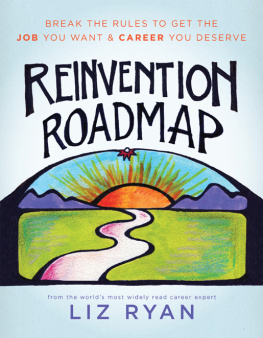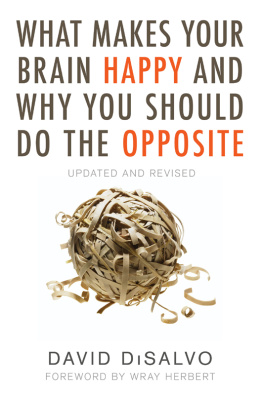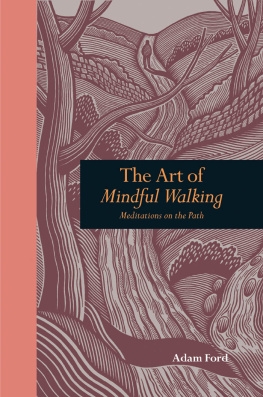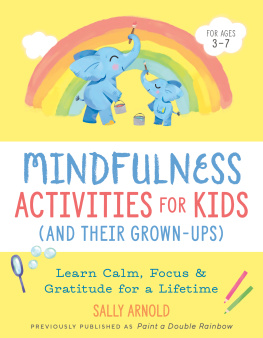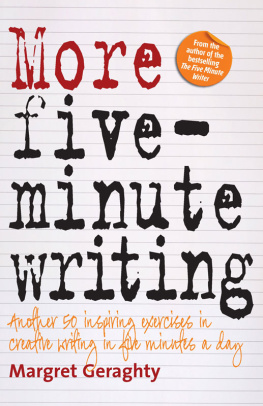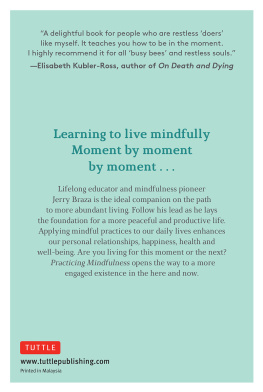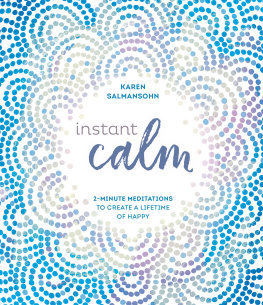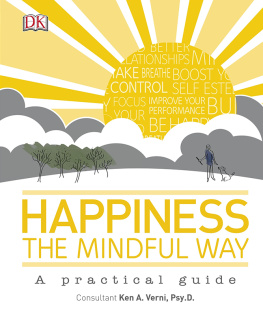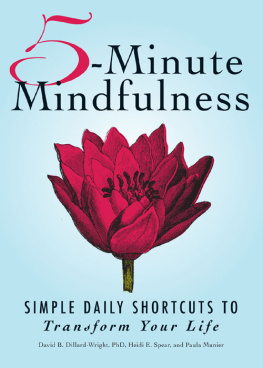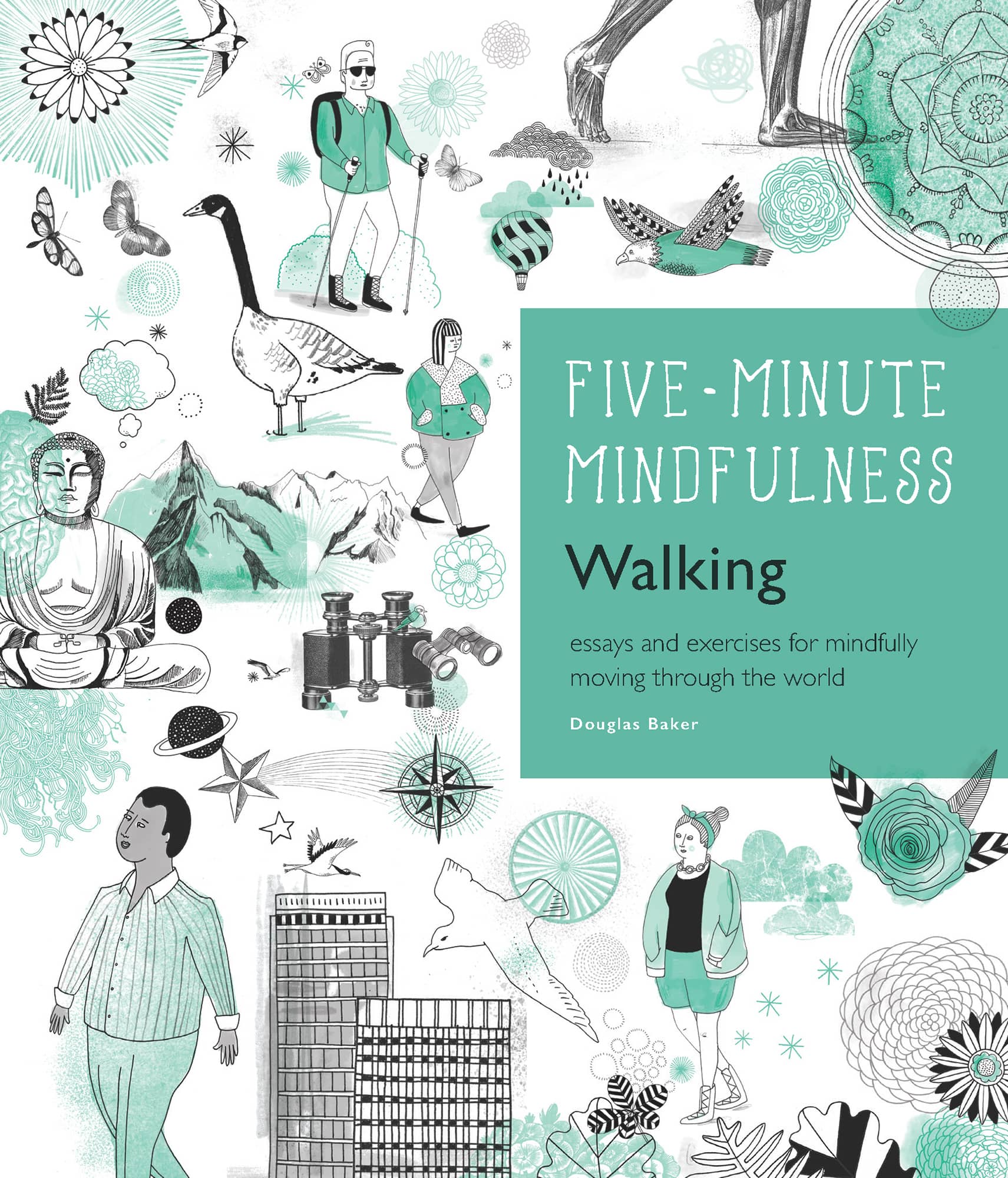FIVE-MINUTE MINDFULNESS
Walking
essays and exercises for mindfully moving through the world
Douglas Baker


Copyright Quid Publishing 2016
First published in the United States of America in 2016 by
Fair Winds Press, a member of
Quarto Publishing Group USA Inc.
100 Cummings Center
Suite 406-L
Beverly, Massachusetts 01915-6101
Telephone: (978) 282-9590
Fax: (978) 283-2742
QuartoKnows.com
All rights reserved. No part of this book may be reproduced in any form without written permission of the copyright owners. All images in this book have been reproduced with the knowledge and prior consent of the artists concerned, and no responsibility is accepted by the producer, publisher, or printer for any infringement of copyright or otherwise, arising from the contents of this publication. Every effort has been made to ensure that credits accurately comply with information supplied. We apologize for any inaccuracies that may have occurred and will resolve inaccurate or missing information in a subsequent reprinting of the book.
Digital edition: 978-1-63159-339-0
Hardcover edition: 978-1-59233-746-0
Conceived, designed, and produced by
Quid Publishing
Part of The Quarto Group
Level 1 Ovest House
58 West Street
Brighton BN1 2RA
England
Design and layout by Lindsey Johns
Illustrations by Tilly and Tonwen Jones
To Yoganand, Shobhan, Danna, and Lucie, and all the other teachers, seekers, and fellow travelers who've encouraged me, and so many others, on the path.
Introduction
WHAT IS MINDFULNESS?
M indfulness is a state of mind. Its about noticing your thoughts and actions in a non-judgmental, open way, as they happen, so that you dont get lost in distractions, reactions, or worries. In mindfulness, you use the minds natural capacity to be attentive, non-reactive, and relaxed. You then connect to whats actually important, inside and around you. Its an intelligence we all have but often dont use.
Mindfulness is typically accessed through meditation. From this open, focused mind state, we more clearly distinguish right actions from fruitless struggle. We get clearer about when were trying to control things we cant possibly control, and better at perceiving our inner reactions before they become regrettable outward actions. We begin to see how much of our stress is created inside the mind. And we start to experience a stillness of mind and body that doesnt require the glass of wine, medication, or hour of massage. With a little persistence and patience, a kind of balance and nobility is glimpsed in the mind.
MINDFULNESS IS A WAY OF USING THE MIND SO THE MIND DOESNT USE YOU.
Mindfulness is sometimes falsely equated with being passive and disconnected. Not so. Its not about becoming checked-out, dreamily floating on a cloud. Mindfulness is a way of being present, focused, and skillful with whats happening in your life, with less struggle. Its an empowering tool for people living active, engaged lives. It helps us to act more efficiently, waste less energy in mind-made dramas, and orient to whats real. The truth will support us, a teacher of mine once said. A fantasy will not. Mindfulness helps us find whats true.
And perhaps best of all, its free, organic, and locally produced. Its right under your nose, or in the sole of your foot. Its always there to tap into, no matter where you find yourself. Its not a magic cure, but it is a simple, cumulative method of orienting differently toward life and lifes challenges.
How Mindfulness Works
Mindfulness happens in switching the mind from busy thinking and planning mode to simple observing mode. You can start by directing your attention to a neutral object or process, like your breathing, or the movement of your feet. You then do your best to observe the flow of sensations as you breathe or walkwhich is different from thinking about it. You simply notice. Then, before you know it, youll probably find youre thinking again. No problem. Just turn back to observing the breath or the feet. You do this again and again, in a relaxed, unhurried, non-perfectionistic waysimply returning to observing.
Why the emphasis on this odd state of non-thinking? The thinking mode can dominate our waking hours in unhelpful ways. We get caught up in pointless thoughts about the past, worries about the future, imaginary conversations in which we brilliantly tell the boss how it really isall distracting us from being present for whats happening in any moment.
Thoughts drive our moods and emotions, and anxious thoughts produce anxious body statesincreasing muscle tension, heart rate, and blood pressure. Through mindfulness, we observe our thoughts and gain a clearer awareness of our thought patterns, which can unhook us from detrimental habits. Mindfulness helps us simply to feel what life brings our way, take a breath, and then decide on a course of action. This is a major step toward mental and emotional well-being.
BENEFITS OF MINDFULNESS
According to the American Psychiatric Association, research has reliably established links between mindfulness practice and the following benefits:
Lower rates of anxiety and depression
Boosts in working memory and improved focus and attention
Reduced emotional volatility
Increased cognitive flexibility and information-processing speed
Enhanced self-insight, morality, intuition, and fear modulation
Increased immune functioning
Increased empathy and compassion and improved relationship satisfaction
The Practice of Mindful Walking
Mindfulness is commonly achieved through meditation, a practice that dates back at least a few thousand years, to early Buddhists in what is now India. (Other cultures around the globe have practiced similar mind-focusing methods to achieve higher states of consciousness for millennia.) Meditation is classically done in a seated position, eyes closed, with attention focused on the breath. But there is also a long tradition of taking the practice on the roadmindful walking, the focus of this book.
BETWEEN STIMULUS AND RESPONSE, THERE IS A SPACE. IN THAT SPACE IS OUR POWER TO CHOOSE OUR RESPONSE. IN OUR RESPONSE LIES OUR GROWTH AND FREEDOM.
VIKTOR FRANKL
For some, mindful walking has certain advantages. Many people struggle to focus in seated meditation. Because so little is happening, the mind is all too ready to wander offback to thinking. Lets face it, observing your breath is only so interesting.
Mindful walking provides more for the mind to connect to. Theres something far more concrete to focus on: movements of the body. Thus it tends to be more user-friendly for the novice. Another advantage is that mindful walking doesnt require special time set aside. Many of us want to meditate but find it surprisingly hard to find time for it on a consistent basis. Ive heard many then sadly conclude, I cant meditate. Walking with mindfulness frees the would-be meditator to roam far and wide, cultivating mindfulness in the process of walking itself.




